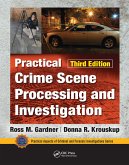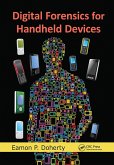INTRODUCTION TO DIGITAL EVIDENCE: Fundamentals and Applications - 1st Edition In today's digital age, the role of digital evidence in investigations is undeniable, with forensic techniques continuously evolving to meet the challenges of the modern world. Introduction to Digital Evidence: Fundamentals and Applications provides a comprehensive introduction to the field of digital forensics, offering essential knowledge and practical insights for those engaged in investigations, law enforcement, or forensic sciences. Key Features: * Fundamentals of Digital Evidence: Explore the history, evolution, and significance of digital evidence in contemporary criminal investigations. Understand the different types and formats of digital data and the sources where evidence is commonly found, such as devices, networks, and cloud storage. * Legal and Ethical Considerations: Gain crucial insights into the legal frameworks that govern the admissibility of digital evidence in court, the importance of maintaining the chain of custody, and the privacy and ethical challenges faced by forensic professionals. * Techniques for Collecting and Preserving Evidence: Learn best practices for collecting and preserving digital evidence, including techniques for imaging storage devices, handling volatile and non-volatile data, and preserving cloud-based evidence. This chapter covers the tools and methodologies used to ensure the integrity of evidence for legal purposes. * Comprehensive Data Analysis: This book provides in-depth guidance on the tools and methods used for analyzing digital evidence, including recovering deleted files, performing forensic analysis on operating systems and applications, and interpreting network traffic and logs. * Types of Digital Evidence: Examine various types of digital evidence, including emails, text messages, multimedia files, and social media activity, along with metadata analysis to understand its forensic significance. * Cybercrime Investigations: Discover how to investigate common cybercrimes, including hacking, digital fraud, online harassment, cyberstalking, and child exploitation, while exploring the latest trends and emerging challenges in digital forensics. * Emerging Technologies: Stay ahead of the curve by learning about the latest technological developments, such as artificial intelligence, the Internet of Things (IoT), and secure devices, that are shaping the future of digital forensics. * Case Studies and Practical Applications: The book features high-profile cybercrime cases, lessons learned from successful investigations, common pitfalls, and strategies to improve investigation outcomes. Real-world case studies illustrate how digital evidence has been pivotal in solving major cybercrimes. * Training and Professional Development: Understand the importance of certifications, career paths, and continuous professional development in the fast-evolving field of digital forensics. Learn about the role of professional organizations and standards, and the capacity building necessary for law enforcement agencies. * Appendices: The book also includes valuable resources, including a glossary of key terms, recommended tools for practitioners, and key legal precedents related to the admissibility of digital evidence. Who Should Read This Book? * Law enforcement and cybersecurity professionals * Forensic investigators and digital forensics students * Legal professionals involved in cybercrime and digital evidence cases * Anyone interested in understanding the fundamentals and applications of digital forensics
Hinweis: Dieser Artikel kann nur an eine deutsche Lieferadresse ausgeliefert werden.
Hinweis: Dieser Artikel kann nur an eine deutsche Lieferadresse ausgeliefert werden.








